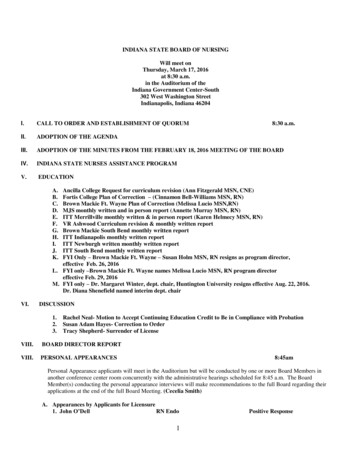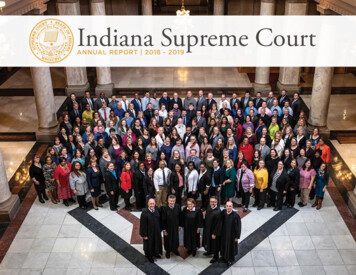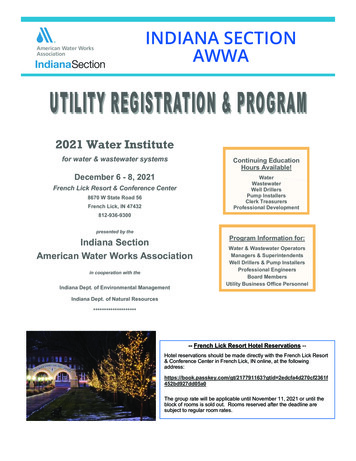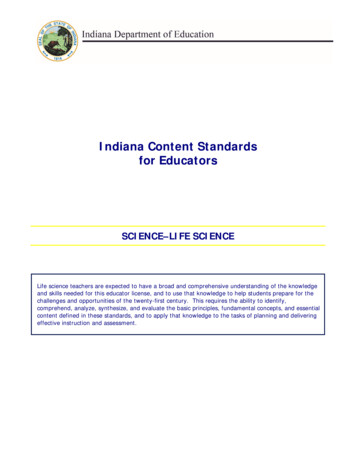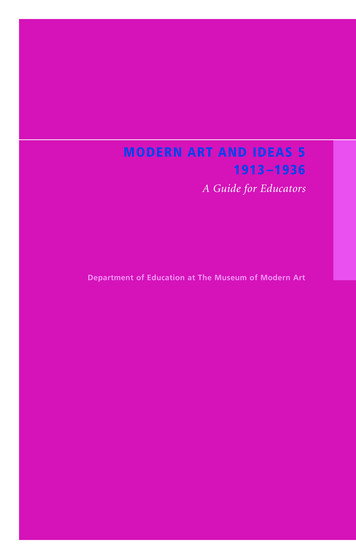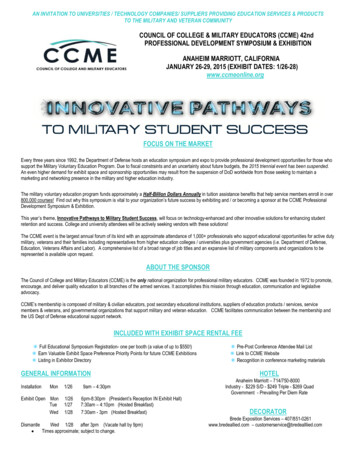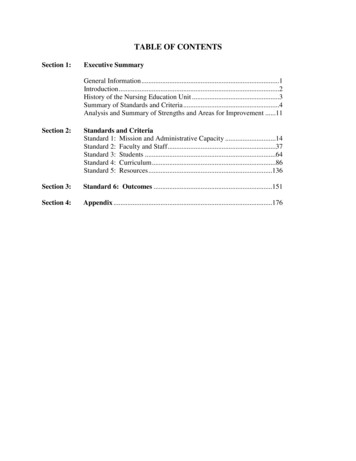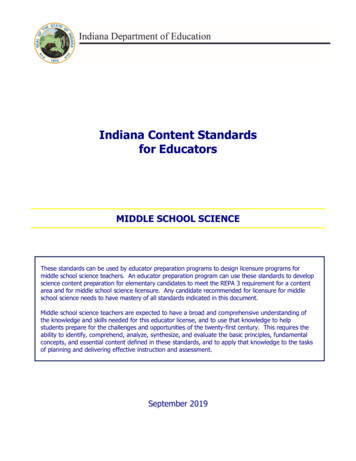
Transcription
Indiana Content Standardsfor EducatorsMIDDLE SCHOOL SCIENCEThese standards can be used by educator preparation programs to design licensure programs formiddle school science teachers. An educator preparation program can use these standards to developscience content preparation for elementary candidates to meet the REPA 3 requirement for a contentarea and for middle school science licensure. Any candidate recommended for licensure for middleschool science needs to have mastery of all standards indicated in this document.Middle school science teachers are expected to have a broad and comprehensive understanding ofthe knowledge and skills needed for this educator license, and to use that knowledge to helpstudents prepare for the challenges and opportunities of the twenty-first century. This requires theability to identify, comprehend, analyze, synthesize, and evaluate the basic principles, fundamentalconcepts, and essential content defined in these standards, and to apply that knowledge to the tasksof planning and delivering effective instruction and assessment.September 2019
Middle School ScienceEducator StandardsStandard 1: The Nature and Processes of ScienceMiddle school science teachers have a broad and comprehensive understanding of the nature of science and theprocesses of scientific inquiry.Standard 2: Central Concepts and Connections in ScienceMiddle school science teachers have a comprehensive understanding of the core ideas and principles that connectdifferent scientific disciplines and of the relationships between science, engineering, technology, and society.Standard 3: The Nature and Processes of Engineering and Engineering DesignMiddle school science teachers have a broad and comprehensive understanding of the core ideas and principlesbehind engineering practices and design.Standard 4: Physical ScienceMiddle school science teachers have a broad and comprehensive understanding of physical science.Standard 5: Earth and Space ScienceMiddle school science teachers have a broad and comprehensive understanding of Earth and space science, theuse and management of geologic resources, and the effects of human activities on the environment.Standard 6: Life ScienceMiddle school science teachers have a broad and comprehensive understanding of the life sciences.Standard 7: Middle School Science Instruction and AssessmentMiddle school science teachers have a broad and comprehensive understanding of content-specific instruction andassessment in science.1
Middle School ScienceEducator StandardsStandard 1: The Nature and Processes of ScienceMiddle school science teachers have a broad and comprehensive understanding of the nature ofscience and the processes of scientific inquiry, including:1.1characteristics, assumptions, and goals of science1.2tentative nature of scientific knowledge, which is subject to change as new evidence, new tools, or newways of thinking become available1.3principles and procedures for designing and conducting controlled scientific investigations and theformulation of testable hypotheses1.4common tools and materials used in scientific investigations1.5scientific data collection, limiting variables, organization, analysis, interpretation, and communication,including the use of technology1.6role and applications of mathematics in science1.7characteristics and uses of various sources of scientific information and the evaluation of scientificinformation, claims, and arguments1.8role of peer review and critical evaluation of the results of scientific investigations, models, andexplanationsStandard 2: Central Concepts and Connections in ScienceMiddle school science teachers have a comprehensive understanding of the core ideas andprinciples that connect different scientific disciplines and of the relationships between science,technology, engineering, math, and society, including:2.1concepts and processes that unify the scientific, technological, engineering and math fields2.2core ideas and principles that connect the various disciplines of science2.3interrelationships between science, technology, engineering, and math2.4social, cultural, and ethical aspects of science, technology, engineering, and math2.5historical development of important ideas in science from different periods and culturesStandard 3: The Nature and Processes of Engineering and Engineering DesignMiddle school science teachers have a broad and comprehensive understanding of the core ideasand principles behind engineering practices and design, including:3.1basic characteristics, principles, and goals of the engineering design process3.2basic engineering process and its application to real-world situations3.3use of basic criteria and constraints within the engineering design process3.4development of a prototype3.5principles and processes of iterative testing and model usage3.6design solution evaluation, including modifications needed to the design2
Middle School ScienceEducator StandardsStandard 4: Physical ScienceMiddle school science teachers have a broad and comprehensive understanding of physical science,including:4.1characteristics and arrangement of subatomic particles and historical and contemporary models of theatom4.2periodic trends and organization of the periodic table and effect of these trends on the chemical andphysical properties of matter4.3properties of the different states of matter, kinetic molecular theory, the gas laws, and the concepts ofheat and temperature, including heat transfer4.4characteristics and comparisons of elements, molecules, compounds, solutions, and mixtures4.5principles of chemical bonding and types and characteristics of chemical bonds4.6types and characteristics of chemical reactions, factors that affect reaction rates and equilibrium, anddistinguishing between physical and chemical changes4.7basic understanding of the law of conservation of mass, the principles of stoichiometry, the mole concept,and their application in balancing chemical equations4.8basic understanding of acids and bases and their characteristic properties4.9Newton's laws of motion and universal gravitation and their application, including using the vector natureof force and motion4.10basic principles of work, energy, and power and the characteristics and uses of simple machines4.11forms of energy, the transformation of energy from one form to another, and the relationship of potentialand kinetic energy4.12amplitude, wavelength, frequency, and period of mechanical waves and the characteristics andapplications of energy transfer by mechanical waves4.13basic understanding of the properties of sound waves and their propagation in different media4.14basic understanding of the electromagnetic spectrum, nature of light, patterns of electromagnetic wavemovement through different media, and the properties and uses of lenses and mirrors4.15basic understanding of static and flowing electricity, conservation of charge, electric current, potentialdifference, resistance, and parallel and series circuits4.16basic understanding of the properties of permanent magnets and the principles and applications ofelectromagnetic induction3
Middle School ScienceEducator StandardsStandard 5: Earth and Space ScienceMiddle school science teachers have a broad and comprehensive understanding of Earth and spacescience, the use and management of geologic resources, and the effects of human activities on theenvironment, including:5.1origin, structure, and components of the universe5.2characteristics and models of the solar system and planets, movement of celestial bodies, and the effectsof the sun and moon on Earth systems5.3origin, evolution, structure, and composition of Earth5.4geologic time scale, evidence for the major events in the history and origin of Earth, and the principlesand applications of radiometric dating and stratigraphy5.5processes of weathering, erosion, and deposition and the origin of major landforms, including thosespecific to Indiana5.6processes involved in the rock cycle and the characteristics, identification, and composition of rocks andminerals5.7theory of and supporting evidence for plate tectonics5.8hydrosphere, atmosphere, biosphere, and geosphere interactions5.9physical and chemical properties of water, the hydrological cycle, and the characteristics and processes offreshwater systems, oceans, and glaciers5.10structure and processes of the atmosphere and the causes and characteristics of different types ofweather, including meteorological technology and maps5.11basic characteristics of Earth's different climate regions, the global climate system, and changes inclimate that have occurred over the course of geologic time and human history5.12causes and consequences of natural hazards5.13impact of human activities on Earth systems and ecosystems and strategies for reducing these humanimpacts, including the development and impact of common synthetic materials5.14benefits and risks associated with the extraction and management of geologic resources and renewableand nonrenewable energy resources, including those specific to Indiana5.15basic concepts and usage of geologic and energy resources and the basic process of production andtransmission of electric power4
Middle School ScienceEducator StandardsStandard 6: Life ScienceMiddle school science teachers have a broad and comprehensive understanding of the life sciences,including:6.1characteristics of all life and the basic principles of taxonomy6.2characteristics of single-celled organisms and the similarities and differences between prokaryotes andeukaryotes6.3similarities and differences of viruses and bacteria, including the effects on humans6.4processes of photosynthesis, cellular respiration, energy use and transfer in organisms, and maintenanceof homeostasis6.5basic structure and function of cell organelles and plant and animal cells6.6characteristics and functions of common specialized cells in plants and animals6.7structure and function of primary components of the organ systems in humans, plants, animals, and fungi6.8processes of cell division, heredity, and reproduction6.9structure of DNA and RNA and the processes of replication, transcription, translation, and proteinsynthesis6.10basic principles of genetics, patterns of inheritance, and their application to genetics problems, includingthe basic principles and applications of genetic engineering6.11the scientific theory of evolutionary, its supporting evidence, and the process of natural selection6.12relationships between organisms at the species level and among trophic levels, including the impact ofchanges in biodiversity on these relationships6.13interactions between living and nonliving components of ecosystems and the basic interactions betweenorganisms and ecosystems5
Middle School ScienceEducator StandardsStandard 7: Middle School Science Instruction and AssessmentMiddle school science teachers have a broad and comprehensive understanding of content-specificinstruction and assessment in science, including:7.1state and national learning standards for middle school science and in preparing students for high schoolscience7.2instructional strategies and resources for promoting students' development of conceptual understanding,inquiry skills, and scientific habits of mind7.3strategies and skills for planning and designing science instruction that meet the needs of diverse andexceptional learners7.4instructional strategies and communication methods that encourage active inquiry, supportive interaction,literacy, mathematics, creative thinking, and collaboration in the science classroom7.5strategies and resources for promoting students' reading, writing, literacy, mathematics, andcommunication skills in a scientific context7.6instructional strategies that encourage the application of scientific and engineering concepts to real-worldscenarios7.7strategies and skills for selecting, adapting, and using technological and other resources to enhanceteaching and learning in science7.8strategies, skills, and methods for effectively assessing student understanding and mastery of essentialscience concepts and skills7.9safe execution of laboratory exercises, including following procedures, resources, and guidelines formaintaining a safe science learning environment and proper storage and disposal of chemicals andmaterials7.10implementation of content and grade level appropriate classroom management and procedures6
science, the use and management of geologic resources, and the effects of human activities on the . 6.13 interactions between living and nonliving components of ecosystems and the basic interactions between organisms and ecosystems. Middle School Science Educator Standards 6 . inqui




